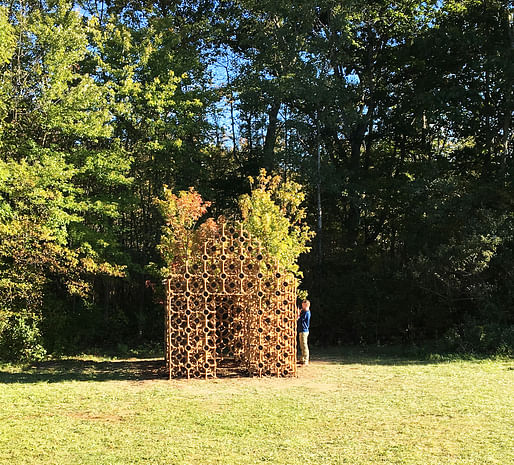
In his Essai sur l’Architecture, the 18th-century French architecture theorist Marc-Antoine Laugier developed the concept of the Primitive Hut. Exploring the origins of architecture, Laugier described the primitive man as constructing a shelter to protect himself from nature. The iconic frontispiece of the second edition, by the artist, Charles-Dominique-Joseph Eisen, made the book's argument clear. It shows an allegorical figure, representing architecture, pointing to the primitive hut, a new structural clarity found in nature.
Martin Miller from Antistatics and Caroline O’Donnell from CODA—previously featured in our Small Studio Snapshot series—partnered with one another as OMG! to create their own Primitive Hut. Inspired by Marc-Antoine Laugier’s work, the duo created a pavilion made of decomposing materials that will open on October 21st at the OMI International Arts Center in Ghent, NY.

According to the architects, the project is meant to question architecture's relationship with time. Through material explorations of growth and decay, the structure actively transforms as it decomposes over the course of its lifespan.
The structure is constituted of two parts—a structural lattice made of interlocking plywood pieces and a decomposing lattice made from sawdust, bio-resin, and hemp, as well as an infill of manure cylinders. The structural lattice acts a growth frame for four red maple saplings while the decomposing material will serve to feed the trees, meant to grow as the structure decays.

The design of the structure is based on digital cellular solids, a system developed by Kenneth Cheung at NASA that optimizes the strength to weight ratio. Acting as a macro-scale foam, the structural lattice is able to behave similarly to more massive solid materials while using less materials.
For assembly, 5,000 individual pieces were produced with a CNC machine and later combined into 2,000 'cells.' Building on traditional notched wood joinery, all the pieces were pre-cut and designed to interlock with one another without the need for permanent fixed joints requiring glue or mechanical fasteners.
The work was commissioned from OMI International Sculpture Park and will be in place for two years, after which it will remain only as the trees it gave life to.
9 Comments
OMG love!
(Seriously, I do think this is a lovely idea.)
Manure cylinders pretty much sums it up.
One big difference I see between the original primitive hut and the new version is the amount of wait material from the CNC. It would be interesting to hear about the consideration given to the use of this method and plywood, in regards to the concept of the decomposing materials.
why use real branches when you can cnc your own? and kill 20 times more trees!! yay!
How did "primitive" people build primitive huts without CNC routers?
Aliens
I think an igloo would be perfect for these special snowflakes. It could be recycled as water for those all-important yoga lessons.
I'm really disappointed that they didn't use parametrics to simulate the natural variations in tree branches and the primitive processes of primitive people.
>>> the same idea a few months back (by DSK) >>>Nam Henderson's article - Resurrection City and architect John Wiebenson
>>>illustration frontispiece for the second edition of Laugier's Essay on Architecture (1755), arguably one of the most famous images in the history of architecture. For Laugier, this primitive form represents the first architectural idea and an abstract concept.
Hut/tent: the same form could stand for a number of different concepts, and multiple shapes could be used to represent the same concept. At the same time, numerous interpretations can be suggested for the “HOME” icon (a new contemporary Laugier's hut?)
Block this user
Are you sure you want to block this user and hide all related comments throughout the site?
Archinect
This is your first comment on Archinect. Your comment will be visible once approved.